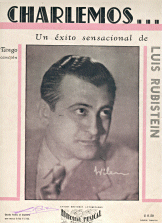By
Charlemos - “Charlemos”, a low blow and popular humor

or Luis Rubistein composing a tango number meant success, he knew quite well how to pose a subject matter into popular taste. The latter was, in no few times throughout history, influenced by bad taste. Otherwise, we would be unable to understand the disproportionate acclaim that received certain tango lyrics in which their wordsmiths turned to low blows to appeal to audiences.
 The tango, “Charlemos”, composed by Rubistein (music and lyrics) in 1940, can be a good example.
The tango, “Charlemos”, composed by Rubistein (music and lyrics) in 1940, can be a good example.
Up to the penultimate stanza, the text refers to a telephone conversation between a man and a woman, that is to say —to be more precise— a love conquest by means of a phone cable.
The “other turn of the screw” —like in thrillers— appears in the final stanza. And that culmination is, precisely, a low blow. Let us remember some of those lines:
¿Belgrano sesenta once?,
quisiera hablar con Renée...
¿No vive allí...? No, no corte...
¿Podria hablar con usted?
Belgrano sixty-eleven? I’d like to talk with Renée...
She does not live there...? Please, don’t hang up...
May I speak with you?
The dialogue had just started. Finally, she agrees and gets this answer:
¿Qué dice? ¿Tratar de vernos?
Sigamos con la ilusión...
Hablemos sin conocernos,
corazón a corazón.
No puedo... no puedo verla.
Es doloroso, lo sé.
¡Cómo quisiera quererla!
Soy ciego... Perdóneme.
What do you say? Would you like to meet?
Let’s go on with this illusion...
Let’s talk without seeing each other, Heart to heart.
I can’t... I can’t see you.
It’s painful, I know.
How much I’d like to see you!
I’m blind. I’m sorry.
The so unexpected as tricky ending, notable shook the audience that, evidently, needed to be shaken with low blows. And “Charlemos” soon turned out into a fashionable tango piece.
It was recorded by Carlos Di Sarli with Roberto Rufino on vocals on February 18, 1941 and on March 11 Ignacio Corsini also did it. But the most successful of those renditions was the one by Alberto Gómez.
However, there was some drawback. The original words began with this line: “¿Retiro sesenta once?”, coinciding, by mere chance, with the telephone number of the railway station of that name. So the jokes started to heavily pour. When the female telephonist answered, she used to hear on the phone: «I’d like to talk to Renée». The complaints by the railway company forced Rubistein to substitute Retiro for Belgrano.
Some recordings of “Charlemos”:
Carlos Di Sarli Orchestra, sings Roberto Rufino (1941)
Ignacio Corsini with guitarists Maciel, Pagés and Pesoa (1941)
Alberto Gómez, with Adolfo Guzmán Orchestra (Cuba, 1941)
Francisco Canaro Orchestra, sings Ernesto Famá (1941)
Enrique Carbel, with Victor label Orchestra (1941)
Roberto Rufino, with orchestra directed by Armando Cupo (1952)
Domingo Federico Orchestra, sings Dante Rossi (1956)
Miguel Montero, with Oscar Castagniaro Orchestra (1968)
Osvaldo Requena Orchestra, sings Héctor Carola (1995)
Luis Cardei, with bandoneon by Antonio Pisano (1995)
Kvitko-Boero-Cotella Tercet, sings Walter Romero (2005)
Olimpo Cárdenas with guitars (Medellín)
Octeto Marabú - Director: Osvaldo Manzi